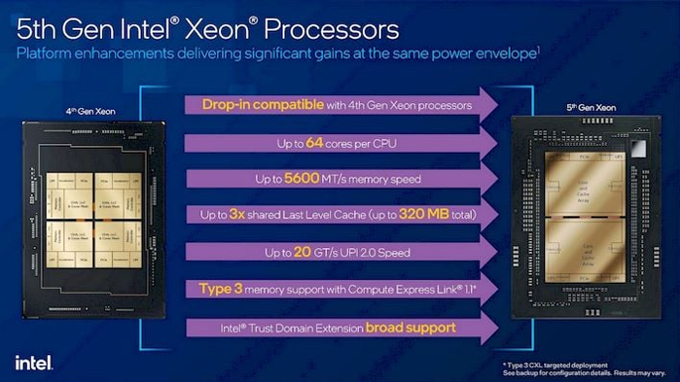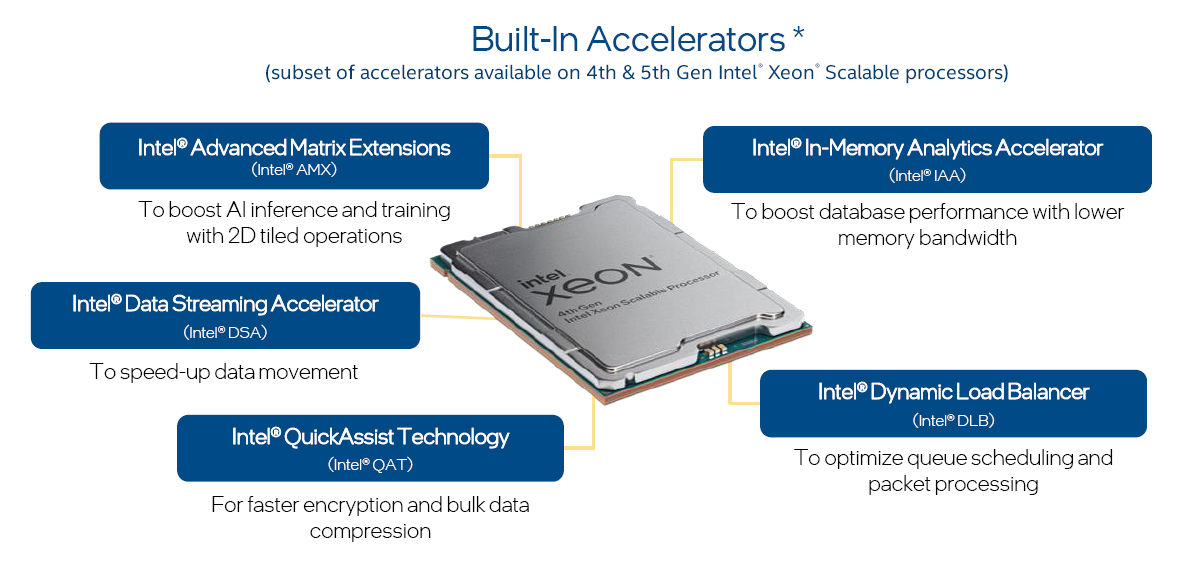
The latest 5th Generation Intel Xeon Scalable Processor, code named Emerald Rapids, follows the same microarchitecture design, leverages the same advanced accelerators, is manufactured on the same Intel 7 node process, and is socket compatible with the 4th Generation Intel Xeon Scalable Processor, allowing both the 5th Gen and 4th Gen families to be used on the same server motherboards and in the same server systems. There are however several changes in manufacturing and packaging that result in up to a 34% gain in performance depending on the application when compared to the 4th Gen product.
One of the primary design changes is that the 5th Generation Intel Xeon Scalable Processor uses two tile dies with up to 32 cores per tile for a maximum of 64 cores, compared to the 4th Generation Intel Xeon Scalable processor which uses four tiles and has a maximum core count of 60. The implementation of dual tiles reduces the complexity of the design by reducing the number of interconnects required to link all the resources. The resulting outcome is lower power consumption and lower latency. Additionally, the two tile design also allowed Intel to increase the amount of shared cache by up to 3x to 320MB. These design and engineering improvements along with a 25% increase in Intel’s UPI 2.0 throughput collectively contribute to the higher performance outcomes.

The 5th Generation Intel Xeon Scalable processor also has additional improvements in memory configurations with support for faster DDR5-5600 memory, up to 12 channels, on certain processor SKUs and support for Type 3 CXL memory, 4 channels, which combined dramatically increase memory capacity and bandwidth critical for big data workloads and other large in-memory databases.
As with the 4th Generation Intel Xeon processor, the 5th Gen series leverages the same accelerators to allow highly compute intensive tasks to be offloaded from the processor to the accelerator to dramatically improve core utilization and performance.
Why Accelerators Matter
It is predicted that by 2025, 90% of all enterprise applications will include some level of AI. Additionally, in the past year nearly 63% of all enterprises were breached to some extent so designing and integrating accelerators that help boost AI performance and help bring a zero trust security strategy to life while increasing overall performance make the 5th Generation Intel Xeon Scalable Processor the best and most flexible choice no matter the deployment path.
Click Accelerator Buttons to Learn More:
4th & 5th Generation Intel Xeon Scalable Processor: Why Accelerators Matter

Intel® Advanced Matrix Extensions - More Info
Intel Advanced Matrix Extensions: AI workloads require strict accuracy and high amounts of compute resources so the addition of accelerators can have a dramatic impact on overall performance. AI applications come in three types including Floating Point 32, Bfloat 16 and INT8. With the release of the 3rd Generation Intel Xeon Scalable Processor, Intel introduced AVX-512 which was an AI accelerator specifically designed for FP32 applications. The benefits were significant and have been enhanced on the 4th and 5th Gen Intel Xeon with the introduction of Intel AMX (Advanced Matrix Extensions) which is an AI accelerator for BFloat16 and INT8. The combination of AVX-512 and Intel AMX provide on chip accelerators for all three AI data types.
Intel Data Streaming Accelerator - More Info
Intel Data Streaming Accelerator: Moving data is essential in order to analyze it and put it to use to drive business decisions. Intel DSA is designed to drive high performance storage, networking and data intensive workloads by offloading the most common data moving tasks. Intel DSA helps speed up data movement across the CPU, memory, and caches as well as attached storage and network devices.
Intel Quick Assist Technology - More Info
Intel Quick Assist Technology: In many use cases today, data encryption is an absolute requirement in order to secure data in flight, at rest and in use. The encryption coding and decoding of data is extremely intensive and can take a significant amount of CPU resources. Intel QAT, which was introduced with the 3rd Gen Intel Xeon processor but is now integrated on chip with the 4th and 5th Gen Intel Xeon processor, accelerates cryptography, private key protection, and data compression.
Intel In-Memory Analytics Accelerator - More Info
Intel In-Memory Analytics Accelerator: Intel IAA allows you to run database and analytics workloads faster, with potentially greater power efficiency. Intel® In-Memory Analytics Accelerator (Intel® IAA) increases query throughput and decreases the memory footprint for in-memory database and big data analytics workloads. Intel IAA is ideal for in-memory databases, open source databases and data stores like RocksDB, Redis, Cassandra, and MySQL.
Intel Dynamic Load Balancer - More Info
Intel Dynamic Load Balancer: Intel® DLB enables the efficient distribution of network processing across multiple CPU cores/threads and dynamically distributes network data across multiple CPU cores for processing as the system load varies. Intel DLB also restores the order of networking data packets processed simultaneously on CPU cores.
Availability of accelerators varies depending on SKU. Visit the Intel Product Specifications page for additional product details.
